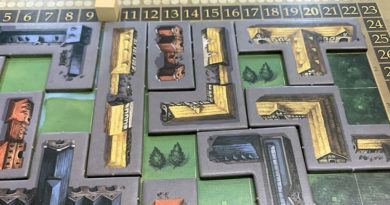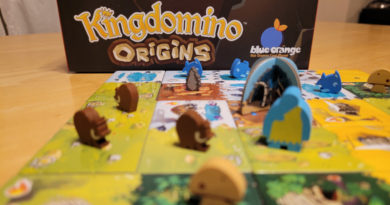Let’s get Trekking the National Parks!
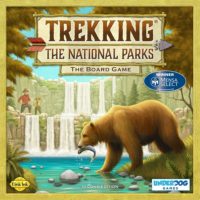
Zion National Park is like a second home to me.
It was my mom’s backyard growing up. So naturally, as a family, we spent a lot of time enjoying its beauty from grandma and grandpa’s farm.
My most memorable summer growing up was the summer I spent living with my grandparents and working in the park.
And heading north, Yellowstone National Park is another one of my favorite places to visit.
Needless to say, I agree with the Ken Burns series, the National Parks is one of America’s Best Ideas.
And when we play Trekking the National Parks the board game by Underdog Games, I get the itch to visit a lot more of the US National Parks.

How to play Trekking the National Parks
Trekking the National Parks has players traveling the United States and visiting National Parks for points. Players utilize dual-purpose cards to both travel between parks and spend as resources to visit and occupy parks. Players also collect colored stones along the way that grant points for majorities.
To begin, each player gets a Trekker pawn and 3 Tents in their chosen color as well as 2 Trek cards from the deck. Players randomly draw colored stones and place one on each Park space on the board. Around the board, 5 Trek cards are placed face-up next to the Trek deck as well as 3 Park cards next to the Park deck. Lastly, 3 Major Park cards are drawn and also placed face-up next to the board.

Each Trek card has a number and a color. The number is used when moving and the color is used with claiming and occupying parks. Each Park card shows resource colored icons and a number. The icons represent what must be spent to claim or occupy that park and the number is the victory points for doing so.
On a player’s turn, they take 2 actions:
Draw a Trek Card: The player can either draw one of the face-up Trek cards or the top card from the deck.

Move: The player discards as many cards from their hand as they choose to travel the trails. The combined value of the numbers on the discarded card(s) indicated exactly how many trails they travel. If there’s a stone on the final destination, the player takes the stone. Trekkers can not cross paths with other Trekkers. However, they may end their move at a location with another Trekker pawn — in which case they bump that Trekker back to the Start space.
Claim a Park Card: To claim one of the 3 face-up Park cards, the player’s Trekker must be at the Park location on the board. They discard cards matching the icons on the Park card and take the Park card. After claiming the card, the player reveals and adds another Park card to those face-up so that there are always 3 available.

Occupy a Major Park: To occupy one of the 3 Major Parks, the player’s Trekker must be at the Park location on the board. They discard cards matching the icons on the Major Park card and place one of their Tents on the card. The player now gets the special ability granted by that Major Park.
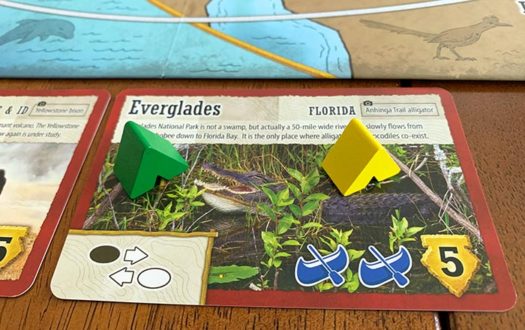
Players continue taking turns until either all stones have been collected from the board or one player has claimed 5 Park cards. Once this occurs, players finish the current game round and the game ends.
Players add up their points from claimed Park cards, points from occupied Major Parks, and points for the most and second-most stones of each color. The player with the most points wins!

Can the whole family enjoy Trekking the National Parks?
Trekking the National Parks is a board game that’s great for the whole family. The rules are simple to understand and remember and the gameplay is straightforward. Plus, it’s a game that has a great balance of strategy and luck.
And games with that good balance are great for families to play together.
There are enough choices to keep the game interesting every time. And there’s also the element of luck in which Trek cards are drawn and which Park cards appear.
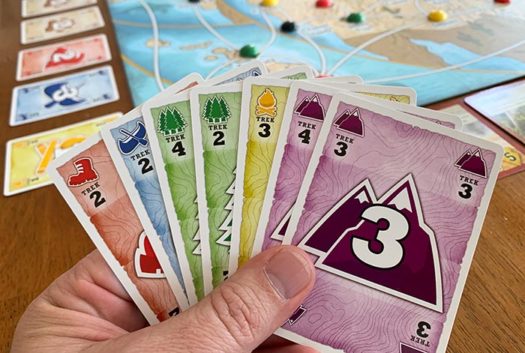
The game also feels a lot like the modern hit board game Ticket to Ride. In both games, players collect colored cards they’ll use to claim stuff. In Ticket to Ride, players use the cards to claim train routes between cities. In Trekking the National Parks, players use the cards to claim National Parks.
However, the additional element of movement with the cards in Trekking the National Parks helps it stand apart.
We really enjoy the dual-purpose use of the Trek cards in the game. It adds a layer of choice to which cards to draw that Ticket to Ride doesn’t have.
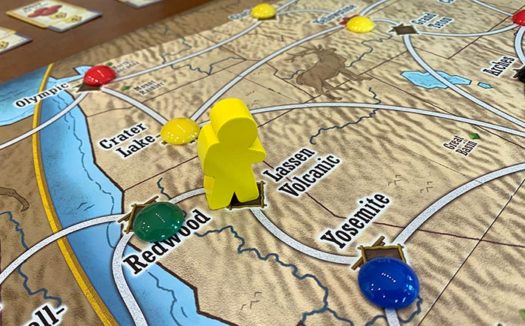
There’s also more of a race element to Trekking the National Parks. Since only 3 Park cards are face-up at a time, players may race for those locations — because players must be at a location in order to claim that Park card. So it could be that you’re heading toward a location and another player snatches it just before you can get there.
And that’s where the element of luck jumps back into the game. When new Park cards are revealed, you may be in just the perfect location, with the right set of cards in your hand to take advantage of it.

Of course, the game isn’t all about the luck of which Park cards pop up when. The Major Parks add an element of strategy that players can’t ignore.
There are 6 Major Park cards in the game. But only 3 will be randomly selected at the outset for each game. And each Major Park has a different special ability. Thus, strategies may change each game depending on which Major Parks are in play.
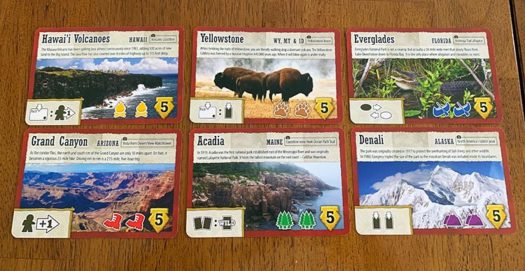
The special abilities add a nice twist to the general flow of play. A couple of the Major Parks grand one-time use special powers like swapping a stone with another player (Everglades) or immediately drawing 2 Trek cards (Denali). The other 4 Major Parks grant abilities that can be used the remainder of the game. It’s great to grab these early if you can.
Occupying Acadia lets you use any 2 Trek cards as one wild card. Occupying Grand Canyon lets you add 1 to your movement. Occupying Hawai’i Volcanoes lets you immediately move to a connected Park when you claim a Park card. And occupying Yellowstone lets you immediately draw a Trek card each time you claim a Park card.
And the last element of strategy in the game comes from collecting stones. At the outset of the game, the colored stones are randomly distributed. But there is also a different amount of each color stone in the game. Thus collecting the majority in different colors will grant a different amount of points. So paying attention to which colors the other players are collecting is a good thing.
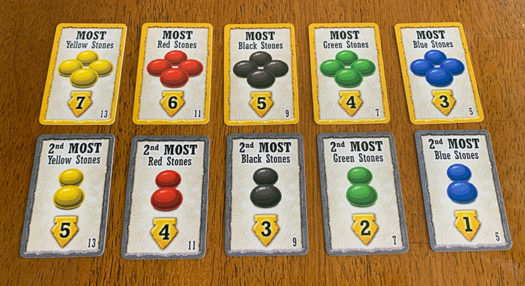
If you plan your routes wisely, you can bump ahead in points by how you collect available stones.
Yet even though there are a number of things to think about during the game (movement, claiming parks, special abilities of Major parks, and stone collecting), they’re not deep thinking choices. Overall, it’s still a fairly light game that’s fun for players of most ages.
Plus, the photos and tidbits of information on the Park cards give us the itch to get out and see more of this beautiful country.

How does Trekking the National Parks score on our “Let’s Play Again” game meter?
 Trekking the National Parks scores high on our “let’s play again” game meter. And I’ll add that it especially scores high with mom!
Trekking the National Parks scores high on our “let’s play again” game meter. And I’ll add that it especially scores high with mom!
Games that hit the mark with mom are definite keepers.
The board game has just the right balance of luck and strategy to give us a good challenge while still keeping it light. And the game doesn’t overstay its welcome either. We have yet to finish a game because of all the stones being taken. Our games have always ended from a player claiming their 5th Park. Which is actually nice because it means the game clipped along nicely.
And since each player only takes 2 actions on their turn, the flow of play is very quick. Which in turn leads to a game that feels just right in the length of time it takes to play.
We haven’t yet played as a 2-player game, but I’m pretty sure we’ll be doing so soon — because with an upcoming wedding and summer ending, mom and I are seeing evenings where it will just be the two of us at home very soon.
Trekking the National Parks gets our thumbs up for a fun game to play with your family.
We’d like to thank Underdog Games for a review copy of Trekking the National Parks.




